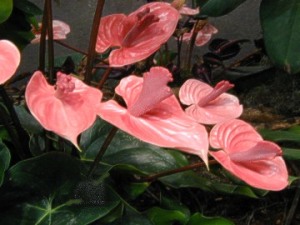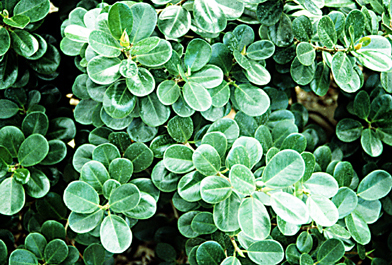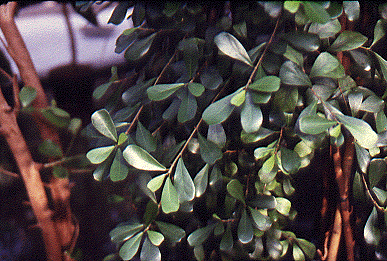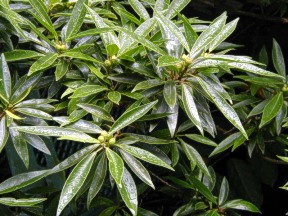
A Touch of the Tropics
Ficus for the Landscape
by Derek Burch
Everyone in the southern halves of Florida and California knows what a
ficus is. Everyone knows that ficus trees are to be avoided more, even,
than crab grass or poison ivy. Planted anywhere in the neighbourhood,
their roots will lift walls and driveways, seek out swimming pools and
crack the lining, and find their way through the sewer lines into the
toilets and bidets of unsuspecting maidens with unmentionable results.
All of this comes from years of misuse by developers who overplanted the
huge species in their quest to develop tree shaded communities overnight,
and have given the whole genus a bad name. It has reached the point where
the use of "ficus" is banned in some communities, and the word itself
causes an automatic negative response.
No one could argue that the large-growing ficus, with their vigorous root systems and ability to thrive on neglect, have a place in the small properties that are the norm in most cities, and neither are species such as Ficus benjamina, F. microcarpa, F. benghalensis and F. elastica suitable choices for street or parking lot trees where tree lawns necessarily are very restricted in size. However, there are some species that are no more than large shrubs when full grown and some trees with restrained growth that deserve to be better known and to be used more commonly.
Let me be more positive: there are some superb plants involved here,
one of which was recognized by the Florida Nurserymen and Growers Association
as a Plant of the Year for the year 2000. This plant is one of two that
have been grown in the United States under the name Ficus 'Green Island'.
They are similar in many ways, but need to be grown under separate names
since they also have major differences. Both are probably forms of Ficus
microcarpa.* One has actually been given a varietal name, Ficus
microcarpa var. crassifolia.**
| Ficus microcarpa var. crassifolia (Ficus 'Green Mound' see below for a note on this name) has heavy-textured leaves a little more than twice as long as wide - about four inches by almost two inches. They are widest a little above the midpoint of the blade (that is, obovate) with a blunt but obviously pointed tip. | |
| Ficus microcarpa 'Green Island' on the other hand, has the same heavy texture but is only a little longer than wide, say three to four inches in either dimension, and the shape would be described botanically as "orbicular" with only an obscure tip |
| These leaf differences are pretty constant,
but even more significant is the growth habit. Green Island tends to spread out sideways and is easy to train as a ground-hugging shrub clinging closely to rocks, across a bed, or even trailing down a wall. |
 |
|
Ficus 'Green Island'
|
|
|
|
The other, var. crassifolia ('Green Mound'), forms a dense mounding dark green mass easily kept below six feet high and about the same width. It is a great screening or background shrub that needs almost no pruning to stay dense and trim. Green Island will also form a similar screening mound if it is not encouraged to stay low by occasional shaping.
|
|
Ficus microcarpa var. crassifolia
(Ficus 'Green Mound')
|
Both these plants are well known to bonsai enthusiasts, who also value another ficus. The name of this one, however, has long been a mystery. It has been sold as Ficus salicifolia, Ficus neriifolia, Ficus subulata and even Ficus mexicana among other names. Some of these are suitable epithets to describe the plant's narrow leaves, but, unfortunately the names belong to other species with much larger leaves and other characteristics that do not fit the bonsai species. |
|
This was truly an unknown in spite of having been widely grown for many years, but a ficus specialist has now checked the situation and found it to be a new species. He has proposed to call it Ficus salicaria, and it will be published as that once the the rules to make that name official have been followed. [Editor's note: the name is now published. |
|
|
Ficus salicaria
|
These are not the only ficus worth considering for the subtropical landscape:
Ficus pumila the creeping fig, can be relied on to cover walls
and tree stumps (and, incidentally, has good salt tolerance). Ficus
montana, (formerly F. quercifolia) the oak leaf fig, is another
ground cover, although not as dense in its growth.
 |
Among the tree species, Ficus rubiginosa is a favorite of mine for its dark leaves and restrained growth, and Ficus lingua (sometimes offered in the industry as Ficus buxifolia) is usually a small tree in cultivation, although in its native Central and West Africa it has been reported at larger sizes. For this reason its current use as an interior plant may be the one to encourage: for this its small leaf size makes it a very good choice. |
|
Ficus lingua
|
*Ficus microcarpa L. A variable species long misnamed in the industry in the United States as Ficus retusa or Ficus retusa 'Nitida.' This is the Cuban laurel that is shaped by hand so wonderfully in many streets and city squares in Latin America. Normally such a great host for the Cuban laurel thrips that their presence is practically a diagnostic feature, this characteristic is fortunately not found in the selections under discussion here. **Ficus microcarpa var. crassifolia One of the two plants that entered the Florida trade as Ficus 'Green Island' in the mid '70s. Both have at times been sold as Ficus 'Panda' or Ficus americana 'Panda' in Europe. Since the name Green Island will be used for the round leaf form, this one needs a cultivar name since neither the industry and general public are going to use the full scientific name (believe me!). Ficus 'Green Mound" would be appropriate for its growth form, and has been proposed and adopted. The round leaf form has been sold under the name "Green Jade" in Europe, but this cultivar name does not appear to have made the transatlantic crossing, so that the more familiar 'Green Island' is maintained here.
Back to Table of Contents
